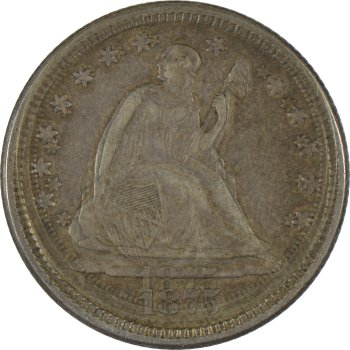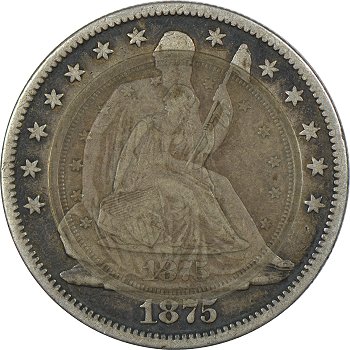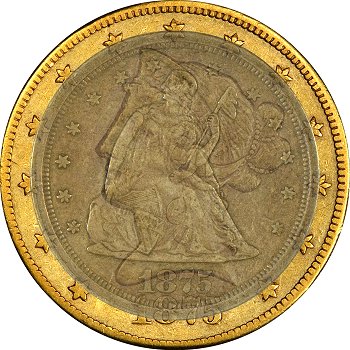3 Misplaced Dates
A misplaced date is a slightly misleading term that describes a digit or set of digits that appear on a coin but are not part of the coinís original design. These digits are in
addition to the coinís normal date. As such, they are out of place on the coin and represent an error in hub and die preparation process prior to a coin being struck. This type
of error in the die making process occurs prior to striking resulting in a variation from the original design that is repeated on each coin struck by an affected die. These varieties
are commonly referred to as coins with a misplaced date (MPD).

Misplaced Date: top of an 8 in the denticles
Twenty-cent pieces are rich with misplaced dates. It is actually more common to find examples with misplaced dates than without the extra digits. As the die marriages of twenty-cent pieces are studied, a few observations can be made that help explain the origin of misplaced dates for this series.
Misplaced dates are only found on the obverse. While this may appear to be an obvious finding, there is a theory about the cause of misplaced dates that would support at least some examples being found on reverse dies.
Misplaced dates are only found in the denticles. Although misplaced dates are known to exist closer to the center on other coins, such as the Indian Head cents, twenty-cent pieces are only known to have misplaced dates on the periphery.
Misplaced dates are only found immediately below the date on the coin. Despite many obverses being made with misplaced dates, all known examples have the additional digits just beneath the date.
All of the known misplaced dates for 1875 are on different obverse dies indicating that the additional digits were placed onto the working dies. Since only one misplaced date is known for 1876, no conclusion can be made for that year.
These four key characteristics indicate consistency with respect to how the misplaced dates made their way onto the working dies. This helps to narrow the explanations as to the possible
genesis of misplaced dates for the twenty-cent piece series.
A few general theories have been proposed to explain misplaced dates. The first of these is that of impaired workers at the Philadelphia Mint. While reports of a rum allotment have been
blamed for errors in the late 18th and early 19th century, there is no evidence of impaired workers during the time the double dime dies were produced.
Another theory is that a digit punch was used to test the hardness of the dies following the annealing process. While this sounds certainly more probable than drunken die sinkers, it also
was likely not the cause. If dies were tested for hardness following annealing, then it is reasonable to assume that at least some of the reverse dies would show the same evidence of testing.
So far, no reverse dies in the double dime series are known to have a misplaced date or other sign of testing. It is therefore unlikely that a digit or date punch was used to test hardness
resulting in a misplaced date.
One theory suggests that misplaced dates are the result of a dropped punch. Digit punches were used for the date on the obverse and letter punches were used for the mintmark on the reverse.
If misplaced dates were truly the result of a dropped punch, one would expect to see the result of dropped punches on the reverse. Namely, a stray ĎSí or ĎCí somewhere on the coinís reverse.
No such examples are known. Also, if the date punch was dropped on the obverse die, the location of the misplaced dates on the coinís obverse should be somewhat random. All known misplaced
dates in the twenty-cent piece series occur within a small area beneath the date on the coin indicating anything but random placement.
A reasonable theory hypothesizes that the workers were inexperienced and just did not have the skill to place the date in the correct location. This theory does explain why the location of the
misplaced dates on twenty-cent pieces is consistent since it is reasonable that an inexperienced worker would at least be close with the date punch. It does not, however, explain why the
misplaced dates are only known to be below the date and at almost exactly the same place in the denticles. It is reasonable that an inexperienced worker would err in date punch placement
and that such a misplacement would vary in the general vicinity of the correct location. As such, one would expect to find misplaced dates above the denticles and perhaps even above the date.
No such examples are known for twenty-cent pieces. Thus it is unlikely that inexperience alone was the culprit.
Misplaced dates on twenty-cent pieces are consistent. All are known to occur in the denticles just beneath the date. The one theory explains how misplaced dates are consistently made on
twenty-cent pieces is the use of an incorrect setup for punching the date. This theory supports the use of a punch alignment jig to assist the workers to correctly place the date on the die.
If the wrong punch alignment jig was used, and used consistently, then it is easy to understand why the misplaced dates are in the same location when present on the coins.
An assumption of this theory is that a punch alignment jig was used to punch the dates in the obverse dies. If such an assumption can be made, then it is a matter of determining which punch
alignment jig was used when the misplaced digits were punched. Since the twenty-cent piece was a new denomination with new dimensions, it is possible that a new punch alignment jig had to be
created or an existing one had to be used.
Assuming that the Philadelphia Mint may not have wished to slow production by waiting until a new punch alignment jig was fabricated, it is reasonable that an existing one would be placed into
service. Since the use of a punch alignment jig is only a theory, then the orientation and placement of the jig with respect to the die is only speculative. It is not known whether a die was
placed in the center, at the top, or at the bottom of the punch alignment jig. In other words, it is also not known how the die fits into punch alignment jig.
Using images of the various denominations struck during the mid-1870s, there are a few possibilities to examine assuming a specific alignment of the die with the punch alignment jig. When
images of a twenty-cent piece are aligned with the top or bottom of various denominations, no images overlap in a way that perfectly explains the misplaced dates in the twenty-cent pieceís
denticles. The quarter dollar comes close, but the position of the resulting misplaced date would be much higher on the twenty-cent piece than what is known.

Twenty-cent piece superimposed on a quarter, aligned at the top
However, if the images are centered, then a punch alignment jig for two denominations are quite possible. Those denominations are the half dollar and the Eagle, with the Eagle the more likely candidate.


Twenty-cent piece superimposed on a Half Dollar and Eagle, aligned at the center
While any explanation for misplaced dates is only a theory, it is clear that the theory thus far that best explains the known misplaced dates with twenty-cent pieces is the use of a punch alignment jig made for the United States ten dollar gold piece.
